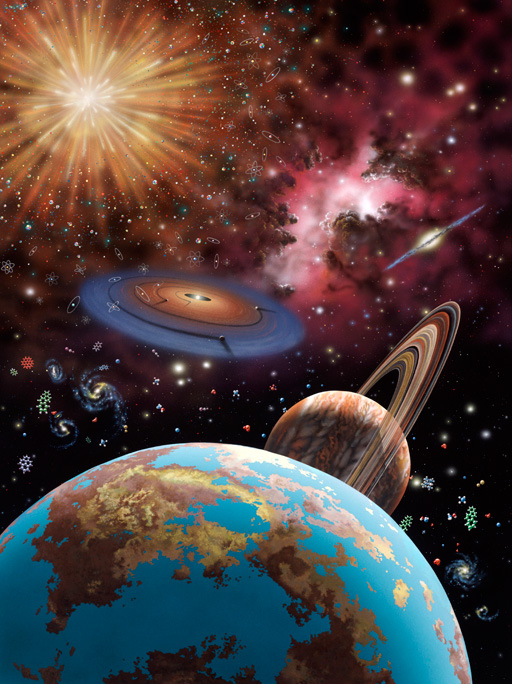1 The Universe today
Astronomy is the study of all celestial bodies and the regions of space that separate them. It is a vast subject: quite literally as big as the Universe. It encompasses objects ranging in size from the incredibly small (the atoms from which planets and stars form) to the unbelievably vast (superclusters of thousands of galaxies, with each galaxy containing many billions of stars). The distances of these objects are also so enormous that the units of measurement, such as kilometres (km), that are familiar to many people on the Earth can't be used. The Universe is around 14 billion years old and contains materials with a range of properties that far exceeds anything that can be replicated in laboratories on the Earth. Temperatures range from close to absolute zero (−273.15 ºC) in dense clouds of gas and dust from which stars form, up to many millions of degrees in the interiors of stars. Although interstellar space is not empty, its density is far lower than that found in the best vacuum chambers on the Earth. In some stellar remnants, material the size of a cube of sugar would have a mass of 100 million tonnes! How can anyone know so much about the Universe when no-one has ever explored or directly measured any of it except the tiny part very close to a rather ordinary star in one of many billions of galaxies, and for only a tiny fraction of the time the Universe has existed?
The 'scientific method' involves the observation or measurement of a phenomenon or property, followed by the formulation of a hypothesis (proposed idea) to explain it, which is testable by an experiment. The results of the experiment may confirm or support the hypothesis or may prove it to be incorrect, in both cases advancing our understanding and leading to further testable hypotheses. This objective approach allows different scientists to repeat experiments to confirm the results, and build on the knowledge and understanding obtained. It has underpinned the development of modern science. However, it cannot be applied to the study of most of the Universe because it's generally not possible to conduct experiments to test a hypothesis. It's only possible to observe the Universe and attempt to explain what can be seen. A hypothesis can only be tested by predicting what else might be seen if the hypothesis is valid, and then attempting to observe it. An observation which matches the prediction provides further evidence (but not necessarily proof) that the hypothesis is valid.
When astronomers make observations, this creates a snapshot of the Universe as it appears now. From this, astronomers must try to discover or deduce the properties of the different objects in the Universe, how they formed, and how they have evolved, over a 14 billion year time span! Many astronomical objects take millions or even billions of years to evolve. We cannot hope to record any process that takes more than a few thousand years to occur (the length of recorded history) or directly observe it for more than a few decades (the working lifetime of a scientist or the time since many modern astronomical methods were developed). Stellar evolutionary processes generally take far too long for anyone to see a noticeable change in their properties (although there are exceptions). It's possible, however, to observe many different stars, all at different stages of their evolution, and try to build a picture of how they relate to each other in order to understand that evolution, in much the same way as attempting to work out the life cycle of a tree by walking through a forest.
The sheer scale of the Universe can help in this process. Objects can be seen from the light they emit. This light travels at a very high but finite speed of about three hundred thousand kilometres per second. The distances to stars are so vast that even at this speed it takes several years for light to reach us from the nearest stars. This is the origin of the use of 'light-years' as a measure of distance.
Why is a unit of time (years) used to measure distance?
Because a 'light-year' is the distance that light travels in one year.
Answering in-text questions
Throughout this course there are in-text questions (marked by a filled-in square), which are immediately followed by their answers (which are hidden until you click on 'Reveal answer'). To gain maximum benefit from these questions you should avoid reading the answer until you have thought of your own response. You will probably find it helpful to write down your answer, in note form at least, before reading the answer in the text.
The light from other galaxies can take many millions or even billions of years to reach us. This means that more distant galaxies can be seen as they were billions of years ago. More powerful telescopes, that allow us to see ever more distant objects, allow us to effectively observe further back in time and develop a better understanding of how the Universe and galaxies formed and evolved. This course summarises the scale of the Universe and the wide variety of objects it contains (Figure 1).

